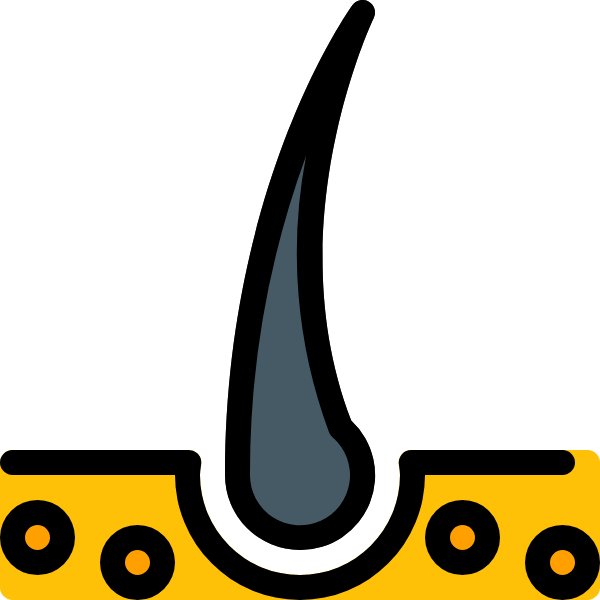Have you ever wondered if the hair fiber products that claim to make your hair look thicker and fuller could be causing more harm than good? Many people might assume that since these products are available over-the-counter, they must be safe. Unfortunately, this isn’t necessarily true; there is evidence that suggests using certain types of hair fibers can cause or worsen hair loss in some individuals. In this article, we’ll take a closer look at how hair fibers may lead to thinning locks.
Hair fibers have become increasingly popular in recent years as an easy way to add volume and thickness to sparse strands. These tiny fibers come in various colors and textures that cling to existing hairs, creating what looks like fuller coverage allover. But while it’s tempting to rely on these quick fixes for a lack of volume, many don’t realize the potential consequences of their use. Let’s explore whether or not adding artificial texture to our manes can actually contribute to more shedding and balding down the road.
Potential Side Effects
Fear, frustration, and anxiety can all be felt when facing the prospect of hair loss. The idea that a seemingly simple solution – like hair fibers – could cause more harm than good is understandably alarming. But what are the potential side effects of using hair fibers?
Hair fibers are made from synthetic or natural materials and applied to existing hairs with static electricity in order to add volume and create a fuller look. While this may seem harmless enough, there have been reports of scalp irritation and itching due to prolonged use of some types of fiber products, as well as possible clogging of pores on the scalp leading to infection or follicle damage. Furthermore, it’s worth noting that for those experiencing thinning or balding spots on their head, these areas cannot be filled in with artificial strands since they don’t contain any actual root structures; instead it’s best to seek out treatments specifically designed for treating hair loss itself.
When considering whether or not to try hair fibers it’s important to weigh up both sides of the argument carefully. Being aware of how you respond personally is key here; if you find yourself developing an allergic reaction then discontinue usage immediately and consult your doctor before trying another type of product. With this knowledge under our belt, let’s explore the science behind hair fibers next.
The Science Behind Hair Fibers
Hair fibers are typically composed of keratin, cotton, or rayon. They work by attaching to the existing hair strands, creating the illusion of fuller, thicker hair. However, some people are concerned about the safety of using hair fibers, as they could potentially clog follicles and lead to hair loss. Fortunately, modern hair fibers are designed to minimize this risk, as they are made with lighter materials and are gentle on the scalp. Additionally, they are usually made with natural ingredients that are safe to use on the hair without causing any damage. Therefore, it is important to choose a product that is designed to be safe and effective.
Hair Fiber Composition
Hair fibers are made up of proteins, which makes them highly complex structures. They’re composed of a protein called keratin, which is what gives your hair its strength and elasticity. This means that if you have brittle or weak hair, it could be due to an imbalance in the levels of these proteins. It’s also important to note that different types of hair require different amounts of these proteins for optimal growth and health.
Your diet plays an integral role in how much protein your body can produce for hair fibers. Eating foods high in vitamins and minerals will help ensure that your body has enough resources to create strong, healthy strands. Additionally, adequate hydration helps promote healthy hair fiber composition as well by keeping cells nourished with essential nutrients.
It’s clear that not only does the way we treat our hair affect its overall appearance but so too do our diets and lifestyle choices. By making sure we provide our bodies with the proper nutrition and taking measures such as using heat protectants when styling our manes, we can maintain beautiful locks while preventing further damage from occurring over time.
Hair Fiber Functionality
Now that we’ve gone over the makeup of hair fibers, let’s dive a little deeper into how they function. Hair fiber functionality is based on their ability to absorb and retain moisture from the scalp. When our locks are adequately hydrated, it helps them maintain their elasticity and strength. If there isn’t enough moisture in our strands, then they can easily become dry and brittle which can lead to breakage or split ends. Additionally, when our tresses lack sufficient moisture, it causes them to be frizzy and unmanageable.
Another important factor in regards to hair fiber functionality is its pH balance. The optimal pH for healthy hair lies between 4-5; any higher than this will cause your mane to become too alkaline which leads to an increase in oil production as well as weakened cuticles that can result in further damage down the road. To keep your locks properly balanced, try using products specifically formulated for color treated or curly hair since these tend to need more acidic formulas due to their delicate nature.
It’s not only vital that you use the right products but also practice proper care techniques such as avoiding excessive heat styling and brushing wet hair with wide-toothed combs instead of brushes. Doing so will help protect your strands while keeping them looking beautiful at all times!
Hair Fiber Safety
It’s important to make sure that the products we use on our locks are safe and non-toxic, as well as free of potentially harmful ingredients. Unfortunately, many hair care products contain harsh chemicals such as sulfates and parabens which can dry out your mane or even cause scalp irritation. To ensure you’re using something natural and gentle on your tresses, always read labels before purchasing any product. Additionally, it’s a good idea to research the brand itself to get an understanding of what they stand for when it comes to their formulations.
When styling your strands, be sure to take extra caution with heat tools such as curling irons and flat irons since these have the potential to burn delicate hairs if used incorrectly. If you’re unsure about how hot is too hot for your type of hair, consult with a professional hairstylist who will be able to advise you based on your individual needs. Lastly, never leave styling equipment plugged in unattended! Doing so creates a fire hazard that could lead to disastrous consequences down the road.
In conclusion, taking proper precautions when caring for your locks is essential in order to keep them looking healthy and beautiful over time. With just a few simple steps, you can help protect yourself from any possible damage while also enjoying all of the benefits that come along with having gorgeous tresses!
Alternatives To Hair Fibers
For those who are looking for ways to reduce the appearance of thinning hair without using hair fibers, there are several options available. Topping the list is a good diet and exercise plan. Eating foods that are rich in vitamins and minerals can help strengthen the roots of your hair follicles, leading to thicker and healthier locks. Additionally, exercising regularly will increase blood circulation throughout your body, including your scalp. This increased blood flow helps nourish your scalp with oxygen and nutrients needed for strong hair growth.
Another way to improve the look of thinning hair is through topical treatments or shampoos made specifically to combat balding spots. These products contain powerful ingredients like biotin or saw palmetto which have been scientifically proven to slow down the rate at which you lose hair. You may also opt for laser therapy sessions that stimulate healthy regrowth while preventing future loss.
No matter what solution you choose, it’s important to be patient as results won’t appear overnight. With proper care and dedication though, you can expect visible improvement over time with any method you decide on.
Conclusion
In conclusion, hair fibers can be a great tool to help with thinning and balding. However, they come with potential side effects that you must consider before using them. It’s important to understand the science behind how hair fibers work in order to make an informed decision about whether or not it is right for you. If you decide against using hair fibers, there are several alternatives out there such as wigs and toupees that may be more suitable.
Ultimately, understanding your own body and personal needs should take priority when deciding on any kind of treatments like this – after all, you know yourself best! So don’t forget to tap into your gut feeling; it’ll never steer ya wrong!

